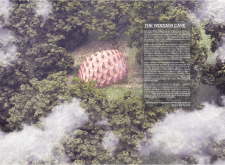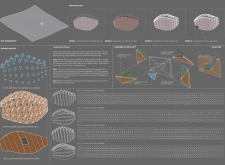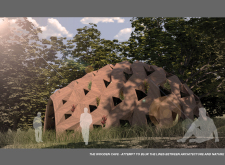5 key facts about this project
At its core, the project embodies a clear function, whether it is a community center, educational facility, or mixed-use development, fostering interactions and enhancing the quality of life for its users. The design employs an open-plan layout which encourages fluid movement and accessibility, inviting users to navigate the space intuitively. Natural light floods the interior through expansive glass façades, creating a bright and welcoming atmosphere that contrasts with traditional, more enclosed designs.
Key elements of the architecture include a diverse selection of materials that not only provide aesthetic appeal but also contribute to the building's sustainability. The use of locally sourced timber and stone establishes a connection to the natural landscape, grounding the project in its origins. These materials are complemented by modern components such as concrete and steel, creating a dialogue between the old and the new. This unique juxtaposition is not only visually compelling but also reinforces the project's commitment to environmental stewardship by reducing transportation emissions associated with material sourcing.
The exterior design features clean lines and a minimalist aesthetic that aligns with contemporary architectural trends while incorporating local architectural vernacular. The variation in heights across different sections of the building adds visual interest and creates dynamic silhouettes against the skyline, further signaling the innovative nature of the project. Roof gardens and green terraces enhance the building's ecological footprint, promoting biodiversity and offering users a serene retreat within the urban fabric.
A paramount discussion point is the project's unique approach to integrating public and private spaces. By featuring shared communal areas, the design fosters community interaction without compromising individual privacy. The design team strategically placed amenities such as seating areas, cafés, and exhibition spaces to encourage socialization and cultural activities, reinforcing the community focus that underlies this architectural endeavor.
Landscaping plays a critical role in accentuating the connection between the architecture and its surroundings. Thoughtfully positioned greenery and water features not only enhance aesthetic value but also contribute to a micro-ecological system, improving air quality and biodiversity. The careful consideration of exterior spaces ensures that the project goes beyond its physical structure, establishing a positive environmental impact that resonates with the local context.
In examining the architectural plans and sections, one can discern how the layout of the project optimally utilizes the site. The orientation of the building is carefully considered to maximize energy efficiency and minimize heat gain. Passive design strategies are employed, allowing for natural ventilation and daylighting, which reduce reliance on artificial climate control systems and make for a more sustainable architectural practice.
The project’s design is a comprehensive example of how thoughtful architecture can address contemporary societal needs while remaining sensitive to environmental concerns. As such, it stands out for its commitment to innovative design solutions that harmonize energy efficiency, aesthetics, and user engagement.
To gain deeper insights into this remarkable project, it is encouraged to explore the architectural plans, sections, designs, and ideas further. Each element contributes to a richer understanding of the project's vision and execution, exemplifying an architecture that is poised to make a lasting imprint on its community and environment.


























